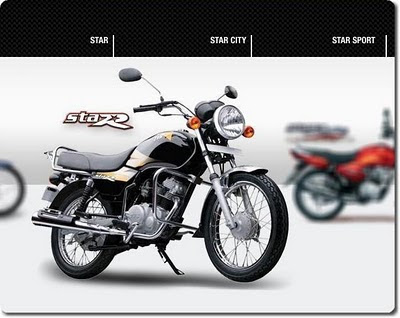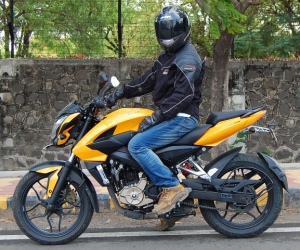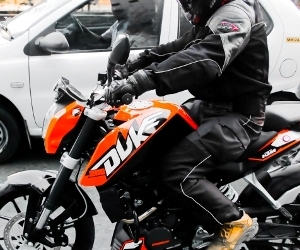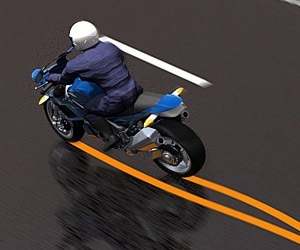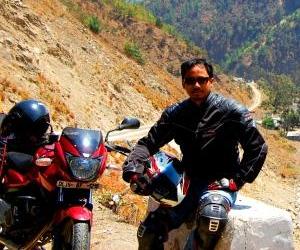My first review of a new motorcycle after a long time... this one has been ridden for a week by me
I have been often accused to be a pro Bajaj, or more specifically a pro Pulsar guy. Let me state once more that without any doubt Pulsar is my most favorite brand. And I am proud to be associated with this brand just like the way I am proud to be an Indian.
So how does a Pulsar Maniac like me feel when a new bike on the block is named as Pulsar 135LS? Is it an insult to the legendary Pulsar brand? After spending a week on the Pulsar 135LS (borrowed from an out of town friend of mine), this is what I like about the bike.
 Review Summary: Positives
Review Summary: Positives Looks: Definitely a handsome "young" Male
Built Quality: As good as the best available in India.
Engine: Snatch free, built to last feel. Pulls easily from speeds ridiculously as low as 22-25 kmph (in 5’th gear) to a class leading 115-120 kmph in 5’th gear..!!
Clutch & Gearbox: Ultra light weight clutch and probably the Best Gearbox for any Pulsar variant from Bajaj.
Handling: Without any doubt the Best handling and the most agile Pulsar variant from Bajaj.
Price: Wallet friendly Rs. 51,000 (Ex-Showroom Delhi)
Mileage: Depends on riding style, but I managed to squeeze out 58-60 Kmpl (Thrice)..!!
But isn’t there anything negative about the Pulsar 135LS? And most importantly does it look, feel and ride to be accepted as a Pulsar..?? Read on..
I. Looks:
The first time I saw the Pulsar 135LS, I was really impressed. It definitely is a beautifully styled bike. Like its older brothers (the bigger Pulsars) the proportions are so pleasing that the bike doesn’t need snazzy stickers/decals or special paint job to distract your attention. Historically Pulsars have never resorted to sticker jobs and so it should remain.
I have no qualms in accepting the 135LS into the Pulsar brotherhood. After all, the bike looks like a handsome teenager. A definitely "young" male..!!
The front is dominated by its uniquely styled headlamp which gets floating panels that encase the glass area and gives the bike the look of a breathing animal. But the best angle to view the bike is from the sides. From the sides the bike has the look of a stretched feline. The trademark Pulsar tank has been replaced by a sleek, compact yet muscular looking one with aircraft style fuel filler caps to boot. The flush fitting tank flaps further adds to the sporty character and neatly flows into the tank.
The way the front portion of the seat blends into the fuel tank is a design element which has been there since the days of the classic Pulsars. The Pulsar 135LS also gets sporty split seats and split rear grab rails. With every tom-dick-harry motorcycles been given the "fear the black" look, the Pulsar 135LS gives a silver finish to the engine cylinder and the engine covers instead. This is actually successful in drawing your attention to the engine covers that has also been given the designer touch with some neat detail work.
The rear tail lamp (with LEDs) and the sharply styled turn indicators have been borrowed from the XCD 135 but look more at home on the Pulsar 135LS. The rear number plate holder has a neat trellis like design made out of aluminum which looks like inspired by the Yamaha R6. The silencer is upswept and has been sharply cut and is in line with the current international trend of stubby silencers.

Dislikes in Looks: The pulsar 135LS looks great from every possible angle. The only part that I found a bit out of place is the rear mud fender, which in a bid to protect from mud splash covers more than 50% of the 100/90 section MRF Zapper. A rear tyre hugger similar in design to ones found on the Pulsar 150 could have made the rear look better. Also a sporty half chain cover instead of the fully enclosed one could have made the rear portion of the bike look lighter and sportier.
Now coming to the important question, does it look like a Pulsar?
Small design details like the way the front seat flows into the tank, the rear split seats and backlit switches does remind of the Pulsar DNA. But strictly speaking, it does look different from the older Pulsars. But even then, I have no qualms in accepting the 135LS into the Pulsar brotherhood. After all, the bike looks like a handsome teenager. A definitely young male..!!
II. Engine performance: I’ll describe it in two parts..
Act I: The sane and sensible commuter:
Thumb start the bike and it comes into life with a smooth crank, which is quite unlike the older Pulsars which lets others around know that it’s coming back to life. The Pulsar 135LS is so silent at idle that in traffic I had to blip the throttle to know if the engine had gone back to slumber. The bike gently moves forward with the twist of the accelerator, which is again quite unlike the older Pulsars which kind of leaps forward from standstill.
Our Indian bikes normally reach their maximum power at around the 7000 rpm mark... and post that these bikes normally feel stressed and out of breadth
This gentle build up of speed might disappoint who expect this to be a speed manic. But at the same time the engine has a crazy ability to pull from speeds as ridiculously low as 22-25 kmph (from near idle engine speeds of 1800 rpm) in 5’th gear..!!
The engine also is snatch free and has got a built to last feel. There is a slight sporty buzz to the engine which feels quite.. well sporty. If not in a hurry, one can virtually ride on 5’th gear the whole day. And in case one needs a quick getaway, a quick downshift and a twist of the accelerator will make you zip forward. The bike might not exactly act like a pocket rocket at low engine revs but as the engine spins above 4000-5000 rpm, one can sense the build up of speed. The bike crosses 60 kmph and everything remains civil and composed, like a well mannered commuter. But then, a Pulsar.. a commuter? Where is the Pulsar grunt gone on this bike?
Intermission:
Just then the cruise party is interrupted by tingling sensations, especially on the right foot. You look down the speedometer and realize that the bike has just crossed 70 Kmph and 6000 rpm. From previous experience on other bikes, you actually expect this as our Indian bikes normally reach maximum power at around 7000 rpm and post this figure, these bikes normally feel stressed and out of breadth.

Act II: Crazy, Insane.. this cannot be a 135 cc engine..!!
As you further twist the accelerator, the tingling intermission ends and the second act starts! Puzzled by the regain in composure of the engine you look at the speedometer which surprising reads 78 kmph. The speed keeps on climbing with the engine remaining eager and cheerful. 80 kmph.. 85 kmph.. Holy $%!T this can’t be a 135 cc engine!!
The speeds reach 90 kmph.. 95 kmph and breaks the 100 kmph as if it does it everyday..!! The tingling sensation now makes a comeback but by now you just don’t care. The engine still feels eager and kind of taunts/dares you. Get into a crouch on an open stretch of empty road and in about 2 kms, you should get to see indicated speeds of upto 115-120 kmph..!!
So does the engine perform like older Pulsars?
Actually no.. it has a character of its own and performs better at higher speeds. It's is a gem of an engine. The shape of things to come for bigger Pulsars..?
III. Clutch and Gearbox:
The very light clutch literally makes light work out of heavy traffic. The only other bike with a similar light clutch is the Yamaha Gladiator. The one-down, four-up gearbox is probably the best Bajaj has so far made. The gearshifts are light and accurate and provide a good feel while shifting through the gears. It is not perfect but at the same time not too far away from perfection either.
Does the clutch and gearbox feel like one from a Pulsar?
No, its actually better.
IV. Handling:
The best part of the Pulsar 135LS is in fact is in its handling. Without an ounce of doubt, this is the sportiest handling bike from Bajaj. The Pulsar 135LS loves corners as a duck loves water. Just think Corner, and the Pulsar 135LS instinctively attacks corners with the agility and stability of a cat.
Even at slow speeds the Pulsar 135LS feels light and can successfully squeeze into tight spaces in our desi traffic. Unlike the bulky older Pulsars, the turning radius is small and the light weight bike (122 kerb kgs) makes things delightful for a city slicker.
So does the Pulsar 135LS handle like older pulsars?
Nope. But do you really need the answer?
V. Ride quality:
Traditionally Pulsars have always enjoyed a plush and back pampering ride quality. But this new Pulsar 135LS in a bid to provide for sharp handling loses that plush ride quality and becomes a bit firm. But then I have enjoyed the handling so much that I am ready to forgive the slightly ride of the Pulsar 135LS.
VI. Mileage/Fuel Efficiency:
I calculated three reserve-to-reserve sessions and every time the calculation came out to around 58-60 Kmpl. During this time I was riding quite normally within the city in medium traffic. Impressive I would say (By the way, my riding style gets me 37-38 kmpl from my Pulsar 220 DTS-Fi).
So is all well with the Pulsar 135LS?
I’ll call a spade and spade and say that the Pulsar 135LS is not free from minor flaws or trade offs.
[1] Looks are subjective but I would have preferred a half chain cover and a Pulsar 150 like tyre hugger instead of the current one.
[2] The engine is a gem but I wish that the slight vibrations at around 6000 rpm (70-78 kmph in top gear) been not there.
[3] The handling is stable and sharp but in the process the ride quality becomes a little bit firm.
[4] The city is the natural habitat of the Pulsar 135LS, and this light weight and sporty bike might not be an ideal choice as long distance tourer.
Verdict:
After spending week on the Pulsar 135LS, I am sure that this pocket rocket can outrun any current 150 cc (maybe except the Liquid cooled and twice as costly Yamaha R15) and deflate the puffed up chests of 150 cc owners. Throw in some corners and the gap and the embarrassment for the 150cc owners will only increase.
Without any doubt the Pulsar 135LS is the sportiest bike in the below 150 cc category with serious ability to taunt the current crop of 150 cc bikes.
Related Posts
Disclaimer:
This is to remind that the Views or Opinions in the blog are entirely mine unless explicitly stated. The Views and Opinions published in this blog should in no way be related to any other person or organization associated -- directly or indirectly -- with me.



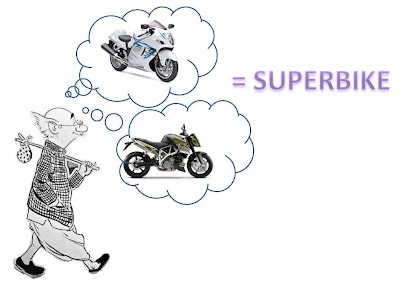
 Honda: CBR 1000RR and CBR600RR
Honda: CBR 1000RR and CBR600RR
 [For more on Superbike racing,
[For more on Superbike racing,  Unlike the 1000 cc and 600 cc models, these two particular 125 cc models do not have a racing category to cater to and are basically beginners’ bikes. But due to the styling inspiration from the bigger 600-1000 cc bikes, the manufacturers have decided to brand these two 125 cc bikes under Super Sports category.
Unlike the 1000 cc and 600 cc models, these two particular 125 cc models do not have a racing category to cater to and are basically beginners’ bikes. But due to the styling inspiration from the bigger 600-1000 cc bikes, the manufacturers have decided to brand these two 125 cc bikes under Super Sports category.




